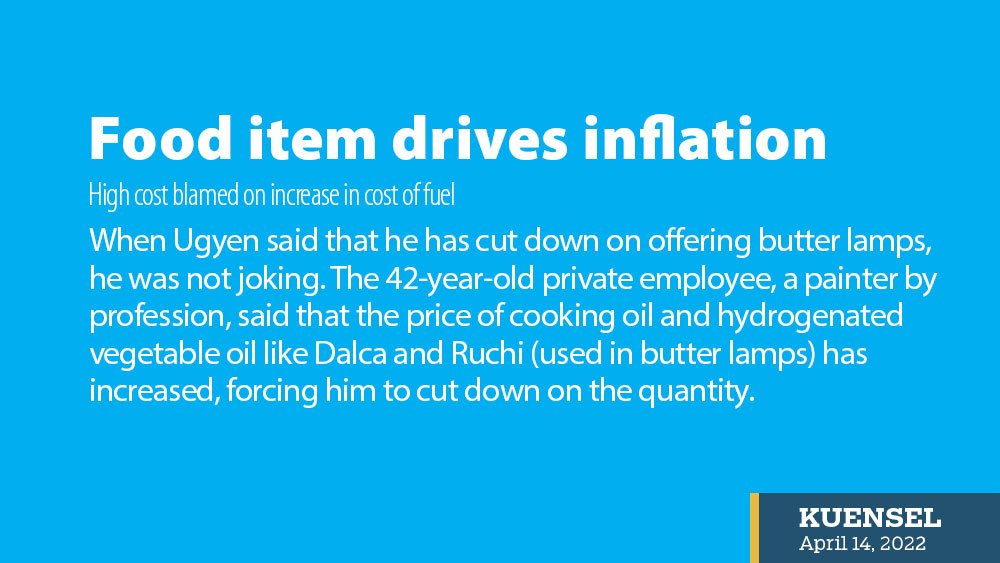High cost blamed on increase in cost of fuel
Dechen Dolkar
When Ugyen said that he has cut down on offering butter lamps, he was not joking. The 42-year-old private employee, a painter by profession, said that the price of cooking oil and hydrogenated vegetable oil like Dalca and Ruchi (used in butter lams) has increased, forcing him to cut down on the quantity.
It may be healthy to consume a smaller quantity of oil in foods, but many are saying that the price of cooking oil has shot up by Nu 30 to 50 a litre or kilogram. The claim can be substantiated by the consumer price index. Prices of food items in the market have increased over the months following the increases in fuel prices.
In April, prices of most imported food items have increased with the sharpest rise seen in edible or cooking oil, which is also attributed to the shortage of cooking oil in India from where Bhutan imports most of its cooking oil.
A kilogram of dalda (Ruchi) costs Nu 170. The maximum retail price is Nu 188. Earlier, it cost between Nu 125 and Nu 130. Similarly, a 3.75 litre of Indian imported cooking oil costs Nu 630, an increase by Nu 80. A few months ago, the same oil cost around Nu 550 to Nu 570.
Shopkeepers are quick to blame the high transportation, which is again blamed on the cost of diesel. A litre of diesel cost Nu 100.67 in Thimphu as of yesterday. “In some of the items the MRP itself has increased,” a shopkeeper said.
Similarly, the 20kg Zheychum chogjur (rice) costs between Nu 1,300 and Nu 1,350. From Nu 1,250 a few months ago. Price of meat items have also increased by Nu 30 to Nu 50 per kilo
However, price of eggs has decreased with the increases in the production of eggs in the country. From an all-time high of Nu 500 to 600, it has not come down to around Nu 290 to Nu 310 per tray (30 eggs).
According to the National Statistics Bureau’s (NSB) Consumer Price Index for the month of February 2022, prices of consumer goods and services in February 2022 increased by 5.32 percent compared to the same month the previous year.
The price index states that the increase in food was due to an increase in the price of cooking oil, sugar and egg by 36.12 percent, 34.41 percent and 27.15 percent respectively.
However, compared to January the prices have decreased by 0.02 percent due to a drop in price of food by 0.70 percent. The decrease in prices of chili, egg and other vegetables led to the overall drop over the previous month. Non-food prices went up by 0.56 percent due to an increase in the price of fuel.
NSB also states that non-food prices continue to record a higher increase with 6.37 percent compared to 4.10 percent increase for the food group. Non-food increases accounted for 62 percent of the overall inflation rate while the remaining was contributed by food prices.
In 2021, food prices contributed about 60 percent of the overall inflation and in 2020 food prices were the main driver of the inflation rate contributing to almost 90 percent of the total increase.
All other divisions recorded an increase except for communication which dropped by 9.90 percent.


